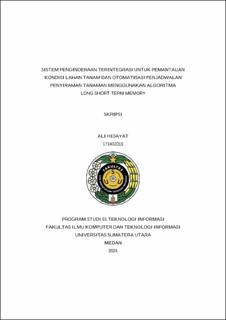| dc.description.abstract | With current technological advancements, humans can utilize technology as an assistant in various fields, including agriculture. Agricultural practitioners, specifically farmers, can leverage technology as an assistant in the crop care stages, such as using agricultural robots. Agricultural robots aim to assist farmers in caring for crops by monitoring the condition of the planting area and working automatically. However, this automation requires optimization, such as power optimization by limiting or scheduling when the robot performs routine tasks, one of which is watering crops. To achieve this goal, the author designed an integrated sensing system to monitor the condition of the planting area and automate the watering schedule by utilizing Machine Learning technology using the Long Short-Term Memory (LSTM) algorithm to predict soil moisture levels. This prediction model also leverages forecasted environmental condition values from a weather data provider and geolocation Application Programming Interface (API) as input for predictions. The data model used consists of soil sensing results, including soil moisture and temperature values, air temperature, and time, collected over three months and then trained using the LSTM algorithm with hyperparameters of 416 layer units, learning rate of 0.001, and training and testing data split ratio of 70:30. The results of the prediction, in the form of soil moisture values, will serve as a reference in determining the watering schedule. The predicted soil moisture values have an average prediction deviation ranging from 5.13% to 5.60%. The final result of this research is the realization of an agricultural robot capable of integrated sensing of the planting area with an automated watering scheduling system that can be monitored through a web- based dashboard application. | en_US |


